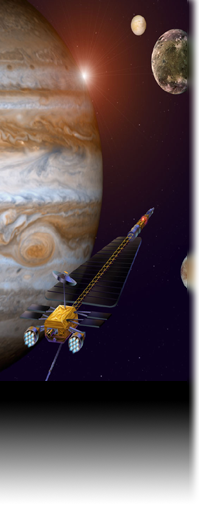| 
|
The
Center recently received a NASA grant to develop a high-capability
Planetary Advanced Radio Sounder (PARS). This high-power,
high-data rate remote-sensing instrument will provide critical
and diverse measurements necessary for detection of subsurface
oceans and for characterization of ionospheres of moons, magnetosphere-moon
interactions, and permanent or induced magnetic fields for
missions to icy moons and other bodies in the solar system.
This information is critical to determining if life is possible
on moons of this type.
The first opportunity to fly the PARS instrument is on the
nuclear electric power and propulsion (NEPP) enabled Jupiter
Icy Moons Orbiter (JIMO) mission whose scientific objectives
include determining the presence and distribution of subsurface
water in the icy moons and determining the nature of magnetosphere-moon
interactions [Science Forum, 2003]. The following five fundamental
scientific measurements can be made by PARS to substantially
contribute to the scientific objectives of SSE Prometheus
class missions (see Figure 1.1).
•Subsurface sounding of solid bodies,
to survey ice stratigraphy underlying visible planetologic
features and to detect presence and location of regional lakes
and global oceans
•Remote magnetospheric sounding, to
obtain electron density distributions along the magnetic field
line through the spacecraft
•Remote sounding of moon ionospheres,
to measure altitude profiles of electron density below the
spacecraft at points along its orbit
•Local sounding, to determine the magnetic
field strength and the electron density at the spacecraft.

Fig. 1.1 PARS
will make five critical measurements for JIMO and other NEPP
enabled missions.
•Passive electric field observations,
to measure natural electromagnetic and electrostatic emissions.
The PARS development, as proposed here,
will be based on the Radio Plasma Imager (RPI) that is successfully
operating on the IMAGE spacecraft [Reinisch et al., 2000].
Because the space environment around the Jovian icy moons
is different from that of Earth, existing RPI instrumentation
will need substantial modifications and advancements in order
to support the accomplishment of scientific objectives for
JIMO and other SSE missions. Five major innovations will be
needed for the PARS over the existing RPI capabilities. These
are:
1) higher transmission power to overcome large sounding ranges
in the Jovian system and to penetrate deep below moon surfaces;
2) enhanced 2-D spatial resolution to resolve structures on
the scale size of 200 m in height;
3) dual-frequency sounding to achieve subsurface sounding
accuracy of a few meters for detection of ocean-related tidal
deformation, to resolve ambiguous signals along the spacecraft
track, and to enable necessary ionospheric correction of subsurface
echoes;
4) multi-frequency transmission and reception to increase
spatial and temporal resolution; and
5) larger operating frequency range to cover the broad sounding
frequencies and all scientifically significant portions of
the radio spectrum.
To guide instrument design and development, we will perform
numerical modeling of radio signal reflections from Jovian
icy moon ionospheres, magnetospheres, surfaces and subsurface
layers.
To achieve the above measurement objectives, the instrument
design will take advantage of the three NEPP enabled capabilities
of the JIMO mission, specifically high power, high data rate,
and high duty cycles.
More info http://www.jpl.nasa.gov/jimo/ |

